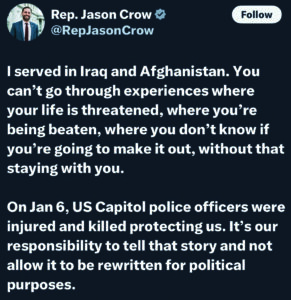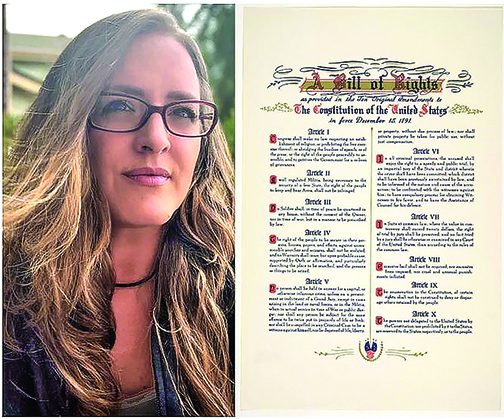ASHE IN AMERICA — OPINION
 Different factions of Americans are living in different realities.
Different factions of Americans are living in different realities.
Earlier this month, the nation observed the fourth anniversary of January 6, 2021. Few things are more divisive than the competing narratives of January 6.
The Very Official Narrative, which Rep Jason Crow (D-CO06) spent most of the anniversary propagating, was wrapped in a bow since the day it launched.
After months of denying the election results, President Trump called his supporters to Washington, D.C. When he spoke to these supporters, he urged them to march to the Capitol, where Congress was certifying the 2020 Electoral College.
These calls to march “peacefully” and “patriotically” were “coded dog whistles” to encourage violence and overthrow the government. They did march to the building, where they forcibly entered, assaulted police, vandalized, and stopped certification. Oh, and five police officers died.
Those that believe the very official narrative are confused that the insurrection isn’t disqualifying. Why are the American People so willing to forgive insurrection?
This confusion is easily resolved. The majority of people — and, based on the 2024 election results, of voters — simply don’t believe the very official narrative. Why?
The easiest answer is that the very official narrative is often very officially wrong. The media — and their sources, many anonymous and not authorized to speak on the matter — have lost the trust of the people.
Enter the alternative story: January 6 was instigated by those with institutional power to end all inquiries into a dubious election. The alternative story is not wrapped in a bow. It’s messy and raises more questions than it answers.
Donald Trump said on January 6 to remain peaceful and respect law enforcement. He respected the chain of command at the Capitol, for which the top was Speaker Nancy Pelosi. Trump authorized all resource requests before and during the riot. Pelosi delayed requests from Capitol Police per former Chief Steven Sund.
President Trump did NOT deploy the military, which should be a good thing, but was later presented as evidence in a Colorado civil court that Trump enabled the mob through inaction. Imagine the very official narrative if Trump had deployed the military, outside the chain of command, on U.S. soil that day.
No one was armed, a dispositive fact for the “coded dog whistle” assertion. Violent coups don’t happen without arms but, instead of being dispositive, this fact is simply dismissed. The narrators claim that the plan was to use barricades and “sharpened flagpoles,” and to steal weapons from police… to overthrow the U.S. government.
It’s very silly when considered without the emotional blackmail of dead police officers.
Also, there were no dead police officers. That was always a lie, and now they claim that the five police officers that eventually died, four of them from suicide and none of them on January 6, died “as a result of the riot.” They deceptively continue to claim five dead police officers, on January 6, at the hands of insurrectionists.
In fact, Trump-supporting protesters were the only people to die on January 6, unarmed and at the hands of Capitol police.
Remember the pipe bombs? Congress was originally evacuated over the pipe bomb threats, not the riot. It’s more than four years later and the pipe bomber has yet to be identified or apprehended. The very official congressional committee ignored this, too.
Speaking of the committee, Pelosi was communicating with the Secret Service on January 6, but their texts have gone “missing.” Pelosi was “off limits” and “not a subject” of the investigation. Her communications and decision making have never been produced or examined. Also, her daughter was making a documentary that day. Her hand-picked committee buried public surveillance videos, destroyed files, and tampered with at least one witness, Cassidy Hutchinson.
Messy and in dispute, the alternative story raises many questions. The very official narrative does as well, but it discourages inquiry and demands trust. But trust cannot be compelled or coerced.
That’s how we got here, occupying different realities, bolstered by our varying levels of institutional trust and underscored by some of the facts, but probably not them all. As shown in the image above, Crow claims that the trauma of Congress that day is comparable to serving in Iraq and Afghanistan. Check out the comments on his post to see how other veterans responded to that claim.
Public trust matters, and convergence — truth and reconciliation — of competing narratives is required to restore it. J6 is an example, but you can imagine the different realities across many narrative domains: economics, climate change, gender affirmation, education, foreign policy.
Convergence is not impossible, but it won’t be easy — people love their comfortable narratives and resist admitting they got it wrong. And everyone got it, at least, a little wrong.
Nothing worthwhile ever came easy, and restoring public trust is certainly worthwhile. Are we brave enough to face what’s true?
Ashe in America is a writer and activist. Find all her work at linktree.com/asheinamerica.

